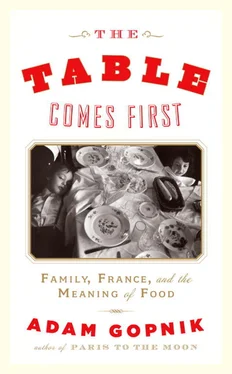Yet, if the first thing a cadet cook learns is that words can become tastes, the second is that a space exists between what the rules promise and what the cook gets. It is partly that the steps between—the melted chocolate’s gleam, the chastened, improved look of the egg yolks mixed with sugar—are often more satisfying than the finished cake. But the trouble also lies in the same good words that got you going. How do you know when a thing “just begins to boil”? How can you be sure that the milk has scalded but not burned? Or touch something too hot to touch, or tell firm peaks from stiff peaks? Define “chopped”? In those days I was illicitly baking in the afternoons, I was learning main-course cooking at night without recipes from my mother, a scientist by day, who had long been off-book, as they say in the theater. She would show, not tell: how you softened the onions, made them golden, browned them. This practice got you deeper than the words ever could.
Handed-down wisdom and worked-up information remain the double piers of a cook’s life. The recipe book always contains two things: news of how something is made, and assurance that there’s a way to make it, with the implicit faith that if I know how it is done I can show you how to do it. The premise of the recipe book is that these two things are naturally balanced; the secret of the recipe book is that they’re not. The space between learning the facts about how something is done and learning how actually to do it always turns out to be large, at times immense. What kids make depends on what moms—or, now, dads—know: skills, implicit knowledge, inherited craft, buried assumptions, finger know-how that no recipe can sum up. The recipe is a blueprint but also a red herring, a way to do something and a false summing up of a living process that can be handed on only by demonstration, a knack posing as a knowledge. We say, “What’s the recipe?” when we mean “How exactly do you do it?” And though we want the answer to be “Like this!” the honest answer is “Be me!” “What’s the recipe?” you ask the weary pro chef, and he gives you a weary-pro-chef look, since the recipe is the totality of the activity, the real work. The recipe is to spend your life cooking.
What is this thing, the recipe? Where did it come from, and how does it work? As the cookbooks keep coming, and we continue to turn down their pages— The Asian Grandmothers Cookbook , The Adaptable Feast , the ones with disingenuously plain names, like How to Roast a Lamb: New Greek Classic Cooking (a good one, in fact, by Michael Psilakis), and the ones with elaborately nostalgic premises, like Dining on the B & O: Recipes and Sidelights from a Bygone Age —we begin to ask, What? Why? Patterns emerge. Changes over time. Once-familiar things depart from their pages silently, like Minerva’s owls. “Yield,” for instance, a word that appeared at the top of every recipe in every cookbook that my mother owned—“Yield: six portions,” or twelve, or twenty—is gone. Maybe it seemed too cold, too technical. In any case, the recipe no longer yields; it merely serves. “Makes six servings” or “Serves four to six as an appetizer” is all you get.
Other good things go. Clarified butter (melted butter with the milk solids skimmed and strained) has vanished—Graham Kerr, the Galloping Gourmet, once used it like holy water—while emulsified butter (melted butter with a little water whisked in), thanks to Thomas Keller’s sponsorship, plays an ever-larger role. The cult of the cooking vessel—the wok, the tagine , the Dutch oven, the smoker, the hibachi, the Tibetan kiln, or the Inuit ice oven, or whatever—seems to be over. Paula Wolfert may have a book devoted to clay-pot cooking, but it feels too ambitious in advance; we have tried too many other modish pots, and know that, like Elvis’s and Michael Jackson’s chimps, after their hour is done they will live out their years forgotten and alone; they’ll end up on the floor of the closet, alongside the fondue forks and the spice grinder and the George Foreman grill. Even the imagery of cooking has changed. Sometime in the past decade or so, the actual eating line was breached. Now the cooking magazines and the cookbooks are filled with half-devoured dishes and cut-open vegetables. Michael Psilakis’s fine Greek cookbook devotes an entire page to a downbeat still-life of torn-off artichoke leaves lying in a pile; the point is not to entice the eater but to ennoble the effort.
With their own torn leaves and unyielding pages, the newer cookbooks show two overt passions: one is for simplicity, the other is for salt. The chef’s cookbook from the fancy place has been superseded by the chef’s cookbook from the fancy place without the fancy-place food. David Waltuck, of the ever-to-be-mourned Chanterelle, started this trend with his Staff Meals from Chanterelle , and now we have Thomas Keller’s Ad Hoc at Home , and, from Mark Peel, of the Los Angeles hot spot Campanile, New Classic Family Dinners . (“Every single recipe was tested in Peel’s own home kitchen—where he has only one strainer, just like the rest of us, and no kitchen staff to clean up after him.”) Simplicity’s appeal as a religion is inherent. But the trend is in part also a reaction to the cult of complexity of the Ferran Adrià school of molecular cooks, with their cucumber foam and powdered octopus. Reformations make counterreformations as surely as right makes left; every time someone whitewashes a church in Germany, someone else paints angels on a ceiling in Rome.
But simplicity remains the most complicated of all concepts. In one month we may stumble over six simple recipes for a ragout or Bolognese—plain spaghetti sauce, as it used to be known, when there was only one kind—with chicken livers or without, diced chuck roast or hamburger, white wine or red. Yet all movements in cooking believe themselves to be movements toward greater simplicity. (Even the molecular gastronomes believe that they are truly elemental, breaking things down to the atomic level.)
Simplicity is the style, but salt is the ornamental element—the idea of tasting flights of salt being a self-satirizing notion that Swift himself couldn’t have come up with. The insistence on the many kinds of salt—not merely sea salt and table salt but hand-harvested fleur de sel , Himalayan red salt, and Hawaiian pink salt—is everywhere, and touching, because, honestly, it all tastes like salt. And now everyone brines. Brining, the habit of dunking meat in salty water for a bath of a day or so, seems to have first reappeared out of the koshering past in Cook’s Illustrated , sometime in the early nineties, as a way of dealing with the dry flesh of the modern turkey, and then spread like ocean water in a tsunami, until now both Keller and Peel are keen to brine everything: pork roasts, chicken breasts, shrimp, duck.
Although brining is defended with elaborate claims to tenderness, what it really does is make food taste salty; we’re doing what our peasant ancestors did, making meat into ham. All primates like the taste of salt; that’s a feature, not a bug. Salted food demands a salty sweet. I read that in Spain recently one connoisseur had “a chocolate ganache coated in bread floating in a small pool of olive oil with fleur de sel sprinkled on it,” while we can now make pecan-and-salt caramel-cheesecake chocolate mousse with olive oil, and flaky-salt sticky peanut cookie bars for ourselves.
The salt fetish has, I think, a deeper and more psychological cause, too: we want to bond with the pro cooks. Most of what a pro cook has to his advantage comes down to the same advantages that Caribbean sugarcane planters used to have: high heat and lots of willing slaves. (The slaves seem happy, anyway, until they escape and write that testimonal, or start that cooking blog.) But the pro cook also tends to salt a lot more than feels right to an amateur home cook; both the late Bernard Loiseau and the Boston cook Barbara Lynch have confessed that hyperseasoning, and, in particular, high salting, is a big part of what makes pro cooks’ food taste like pro cooks’ food. The poor home cook, with no hope of an eight-hundred-degree brick oven, and lucky if he can indenture a ten-year-old into peeling carrots, can still salt hard—and so salt, its varieties and use, becomes a luxury replacement, a sign of seriousness even when you don’t have the real tools of seriousness at hand.
Читать дальше












